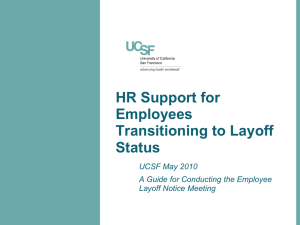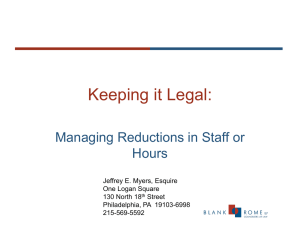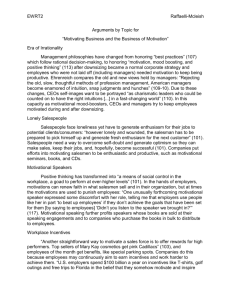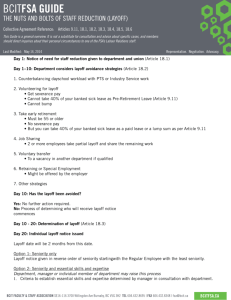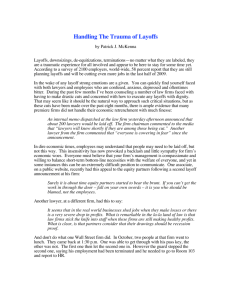An Examination of Employee Layoffs and Organizational Justice
advertisement
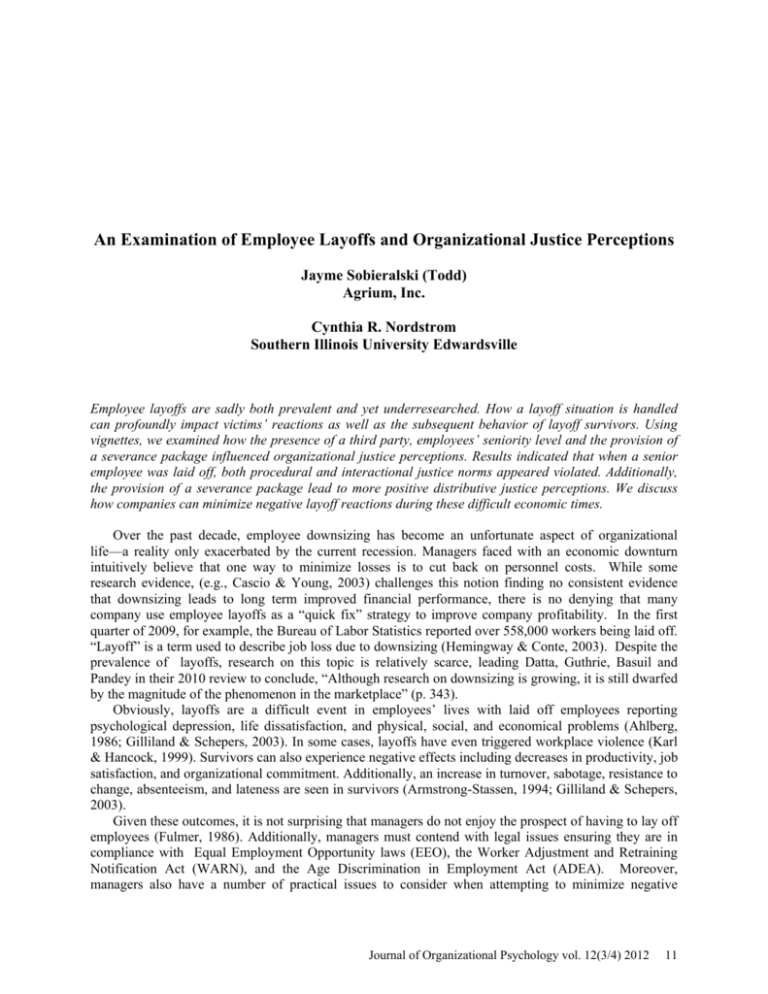
An Examination of Employee Layoffs and Organizational Justice Perceptions Jayme Sobieralski (Todd) Agrium, Inc. Cynthia R. Nordstrom Southern Illinois University Edwardsville Employee layoffs are sadly both prevalent and yet underresearched. How a layoff situation is handled can profoundly impact victims’ reactions as well as the subsequent behavior of layoff survivors. Using vignettes, we examined how the presence of a third party, employees’ seniority level and the provision of a severance package influenced organizational justice perceptions. Results indicated that when a senior employee was laid off, both procedural and interactional justice norms appeared violated. Additionally, the provision of a severance package lead to more positive distributive justice perceptions. We discuss how companies can minimize negative layoff reactions during these difficult economic times. Over the past decade, employee downsizing has become an unfortunate aspect of organizational life—a reality only exacerbated by the current recession. Managers faced with an economic downturn intuitively believe that one way to minimize losses is to cut back on personnel costs. While some research evidence, (e.g., Cascio & Young, 2003) challenges this notion finding no consistent evidence that downsizing leads to long term improved financial performance, there is no denying that many company use employee layoffs as a “quick fix” strategy to improve company profitability. In the first quarter of 2009, for example, the Bureau of Labor Statistics reported over 558,000 workers being laid off. “Layoff” is a term used to describe job loss due to downsizing (Hemingway & Conte, 2003). Despite the prevalence of layoffs, research on this topic is relatively scarce, leading Datta, Guthrie, Basuil and Pandey in their 2010 review to conclude, “Although research on downsizing is growing, it is still dwarfed by the magnitude of the phenomenon in the marketplace” (p. 343). Obviously, layoffs are a difficult event in employees’ lives with laid off employees reporting psychological depression, life dissatisfaction, and physical, social, and economical problems (Ahlberg, 1986; Gilliland & Schepers, 2003). In some cases, layoffs have even triggered workplace violence (Karl & Hancock, 1999). Survivors can also experience negative effects including decreases in productivity, job satisfaction, and organizational commitment. Additionally, an increase in turnover, sabotage, resistance to change, absenteeism, and lateness are seen in survivors (Armstrong-Stassen, 1994; Gilliland & Schepers, 2003). Given these outcomes, it is not surprising that managers do not enjoy the prospect of having to lay off employees (Fulmer, 1986). Additionally, managers must contend with legal issues ensuring they are in compliance with Equal Employment Opportunity laws (EEO), the Worker Adjustment and Retraining Notification Act (WARN), and the Age Discrimination in Employment Act (ADEA). Moreover, managers also have a number of practical issues to consider when attempting to minimize negative Journal of Organizational Psychology vol. 12(3/4) 2012 11 employee reactions. Some pragmatic issues are a) should there be a third party present when notifying the employee, b) should employee seniority influence the decision process, and c) will the organization offer a severance package to the employee? The effect these variables have on employee reactions is of considerable importance. First, laid off employees may decide to sue the company arguing they did not operate in good faith. Second, an organization will want to minimize negative reactions to maintain morale among layoff survivors. Third, an organization’s reputation among customers may be affected by how employees are treated. Finally, laid off employees may later be considered for rehiring should the organization’s financial status improve. To this point, a survey conducted by Right Management found that 18 percent of laid off individuals are rehired by the organization who laid them off initially (www.cnn.com). Employee reactions to layoffs likely depend on whether they perceive they were treated fairly. Shah (2000) argues that employees’ fairness perceptions will be affected by whether they viewed the layoffs as necessary, the criteria used to identify whom to layoff and whether employees were sufficiently provided for after the layoff. When considering fairness, the issue of organizational “justice” is applicable -- a multifaceted construct involving distributive, procedural, and interactional justice concerns (Colquitt, Conlon, Wesson, Porter, & Ng, 2001 ) Distributive justice has been defined as a concern with organizational outcomes such as pay, benefits, status, (de)promotions, etc. (Holtz & Harold, 2009; Mishra & Spretizer, 1998; Saunders & Thornhill, 2003). In the current study, distributive justice may be reflected in whether the organization distributes a severance package, generous benefits, or outplacement services to laid off employees. Procedural justice deals with whether employees perceive that the process used to determine outcomes is fair (such as the system used to determine whom to layoff) (Holtz & Harold, 2009; Mishra & Spretizer, 1998; Saunders & Thornhill, 2003). Are the layoff decisions based on tenure, performance, absence record, merit, etc. or is the procedure perceived to be biased in some way? In the current study, procedural justice may be reflected in whether the supervisor uses a systematic procedure to determine which employees are laid off, such as how long the employee has been with the organization. Finally, interactional justice focuses on how the rationale for decisions is conveyed to employees or the interpersonal communication used (Pinder, 2008). Was the employee treated with respect and dignity (Holtz & Harold, 2009)? In the current study, interactional justice can be reflected in whether a third party is present when the manager communicates the layoff decision. Previous research (Bies, Martin, & Brockner, 1993) has looked at the connection between justice perceptions and layoff victims’ reaction manipulating outcome fairness, procedural fairness, mood state, and the expectation of being rehired. Organizational citizenship behaviors (OCBs) served as the dependent variable assessing if victims still acted like “good” citizens even after they knew of the layoff. Results suggested that procedural fairness perceptions had a significant influence on OCBs. Whether an employee perceives the organization operated justly when implementing layoffs is likely affected by a number of variables. Consistent with this, Karl and Hancock (1999) reviewed professional guidelines associated with “good practice”. First, they suggest it is important to consider who should conduct the layoff session. Usually this is the immediate supervisor although some managers elect to have a third party present. Next, consideration about when the layoff session should occur should be given. Karl and Hancock (1999) suggest the beginning of the week because employees have more time to search for other opportunities and at the end of the day to allow for privacy. Third, guidelines suggest holding the meeting in a private setting. Finally, the authors recommend training to help managers cope with the discomfort associated with employee layoffs. A question arises though as to whether organizations actually follow these “good practice” tips when conducting layoffs. Karl and Hancock (1999) surveyed HR professionals asking them who was present at the layoff session, the meeting location, time of day, day of the week, and whether the supervisor received training. They also questioned if employees reacted in a hostile fashion. Interestingly, the authors found contrary evidence to many of the literature recommendations. For example, employees were actually more hostile when let go early in the week because of possible disruptions to their work week and 12 Journal of Organizational Psychology vol. 12(3/4) 2012 managerial training seemed to make little difference in how smoothly the session went. Employees also were less hostile when only the manager was present as opposed to having a third party present. Given these contradictions, the current study examined three common issues discussed in the layoff literature that are believed to influence employee reactions including third party presence, employees’ seniority levels, and whether a severance package is provided. Having a third party present during the layoff session is typically viewed as good managerial practice as he/she can serve as a witness, provide managerial support and prevent emotions from boiling over (Karl & Hancock, 1999). However, some research has shown when a third party is present (an HR representative or security guard) there is more hostility compared to the manager solely delivering the bad news (Karl & Hancock, 1999). A third person may lead laid off employees to feel humiliated or embarrassed. It has been speculated that employees may feel distrusted when a third party is asked to be a witness (i.e., a lack of interactional justice) (Holtz & Harold, 2009). Examining this issue, Wood and Karau (2008) used scenarios that either depicted an HR representative, security guard, or no one else present during the session. Additionally, either positive or negative elements of performance were mentioned, and finally they manipulated whether the employee was escorted off the premises or was free to leave on his or her own. Having a third party present resulted in employees reporting lower perceptions of respect and being valued. Also, in the security guard condition, employees’ feelings of anger were the highest. Clearly, there are mixed views about having a third party present, but for this study when a third party is present it is believed that people will perceive that the employee getting laid off is being treated in a disrespectful way by management. H1: Having a third party present during layoffs will result in lower perceptions of interactional justice as opposed to when there is no third party present. A second variable examined is how the employees’ seniority level affects layoff reactions. Some organizations use seniority to determine whom to let go when downsizing --employees with the least amount of seniority are typically the first to be laid off. Seniority is often used because it is both easy for management to implement and for employees to understand (Engelstad, 1998). There are drawbacks to using a seniority system though as the strategy clearly rewards years of service and not performance. The organization may also end up retaining employees who will be leaving (e.g., retiring) which could limit new talent or expertise being brought into the workforce. A seniority approach can also have adverse impact on minorities and women (Engelstad, 1998). When organizations lay off low seniority employees, often they are disproportionately minorities and/or women (Armstrong-Stassen, 1994). The current research suggests that layoff reactions will be more negative when the organization lays off senior employees because the process does not reward organizational loyalty (Armstrong-Stassen, 1994; Engelstad, 1998). People may view senior employees as having persevered with the organization, and now the organization is unfairly abandoning them. Consistent with this logic, Cascio and Wynn (2004), suggest that laying off senior employees may be perceived as a violation of the unwritten “psychological contract” between the employer and employee. H2:When senior employees are laid off, procedural justice perceptions will be lower than when less senior employees are laid off. A third variable examined is the provision of a severance package. Severance packages are basically pay and/or benefits (e.g., an extension of health insurance and/or assistance finding a new job) that an employee receives. Severance packages may allow laid off employees more of a financial cushion. For example, Kodrzycki (1998) found that employees receiving severance packages were unemployed a longer time than employees not receiving severance packages. Severance packages may also provide employees the financial wherewithal to retool by undergoing technical training and educational classes. Thus from a purely distributive justice perspective, laid off employees who receive severance packages are obtaining more outcomes than those who do not. Consistent with this, Deutsch (1985) found that Journal of Organizational Psychology vol. 12(3/4) 2012 13 layoff victims reacted more negatively when there were fewer severance benefits offered compared to survivors and lame ducks (i.e., employees still waiting to hear their fate). H3: When employees are offered severance packages when being laid off there will be more positive perceptions of distributive justice compared to when employees do not receive severance packages. METHOD Participants Participants were 148 undergraduate students (101 females and 47 males) at a Midwestern university of various ethnic groups whose mean age was 19.97 (SD = 3.53). Additionally, 79 participants had a part time job, 4 a full time job, and 65 were currently unemployed. Three participants held positions where they conducted layoffs while 16 had been layoff victims. Finally, 132 participants personally knew someone who had been laid off. Design and Procedure This study represented a 2 (third party presence) x 2 (seniority) x 2 (severance package) between subjects factorial design. Because being laid off is a very personal issue and not all companies disclose layoff information, a scenario approach was used which has been utilized to examine other sensitive organizational issues including sexual harassment, gender differences, etc. (Bowles, Babcock, & Lai, 2007; Pesta, Dunegan, & Hrivnak, 2007). In this research, scenarios were adapted from Wood and Karau (2008). Participants were placed into the role of an employee working for an automobile company who had been brought into the office for a layoff meeting. To manipulate third party presence, the scenarios either described the layoff meeting as involving just the boss conveying the decision or the boss plus the HR director. To manipulate employee’s seniority level, the scenarios described the participant as an entry level manager having worked for the company for three years or a manager who had worked for the company for fifteen years. Lastly, to manipulate the severance package variable, the scenarios either described the boss saying “I know times are tough but if we can help you in any way with your transition, please let us know” or saying “I know times are tough but if we can help you in any way with your transition, please let us know and here is a packet containing information about a severance package”. The severance package included additional pay, assistance in finding a new job, and continuation of health benefits. Using Survey Monkey, participants were randomly assigned to one of the eight possible scenarios. Once participants read the scenario, they completed the organizational justice scales, manipulation check and demographic questions. Justice Survey A 15 item survey was created combining modified items from previous questionnaires related to distributive, procedural, and interactional justice (Daley & Geyer, 1994; Folger & Konovsky, 1989; Greenberg, 1993; Niehoff & Moorman, 1993, Price & Mueller, 1986; Sweeney & McFarlin, 1997). Responses were made on a five-point Likert scale with 1=Strongly Disagree to 5=Strongly Agree. The distributive subscale (5 items) assessed participant’s perceptions of how fair organizational allocations were– “The outcome of the layoff decision was fair to me”. The coefficient alpha was .64 and the mean item rating was 2.87 (SD = .64). The procedural subscale (5 items) measured perceptions of how fair participants perceived the procedures used to conduct the layoffs -- “My boss showed a real interest in trying to be fair in determining whom to layoff”. The coefficient alpha was .76. and the mean item rating was 3.17 (SD = .66). Lastly, the interactional subscale (5 items) measured whether participants perceived they were treated respectfully by their managers --“My boss treated me with kindness and consideration during the layoff meeting.” The coefficient alpha was .73 and the mean item rating was 3.36 (SD = .67). 14 Journal of Organizational Psychology vol. 12(3/4) 2012 Manipulation Check Participants filled out a seven item manipulation check to ensure the independent variables were successfully manipulated. Two items assessed each independent variable. The researchers eliminated data that reflected participants had not successfully identified the independent variable manipulations. The seventh item asked whether participants were able to put themselves into the role of a laid off employee. With a mean of 3.93 (SD = .87) on a five point scale, data indicated that participants actively put themselves into the role of employees about to get laid off. Demographics Demographic questions solicited participants’ gender, age, race, and employment status. Participants were also asked if they have ever held a management position and their experience with layoff situations either laying off others or being laid off themselves. RESULTS After examining the manipulation check, the intercorrelations among the study variables were investigated prior to hypothesis testing (See Appendix 1). Because the three justice subscales were significantly correlated, data were analyzed using a MANOVA approach. MANOVA results revealed significant differences between the severance pay conditions on the dependent variables, Wilks’Λ = .84, F(3,138) = 8.89. p < .001, multivariate η2 = .16. Univariate tests were then conducted on each dependent variable. In the interest of brevity, only hypothesized and/or significant relationships will be reported. The complete set of multivariate and univariate results can be found in Table 1 and the means and standard deviations associated with the independent/dependent variables are available in Table 2. TABLE 1 MULTIVARIATE AND UNIVARIATE ANALYSES OF VARIANCE FOR JUSTICE RATINGS Univariate _____________________________________________ Procedural Distributive Interactional Justice Justice Justice Multivariate Source df F__________________________________________________ Third Party (TP) 3 .69 1.78 .76 1.72 Seniority (SEN) 3 2.11 4.05* 1.13 6.21* Severance Pkg (SP) 3 8.89* .88 20.56** 2.83 TP x SEN 3 1.14 .33 1.15 .45 SEN x SP 3 .56 .39 .12 .01 TP x SP 3 .10 .17 .01 .28 TP x SEN x SP 3 1.26 .02 1.56 1.12 MSE .43 .26 .43 ______________________________________________________________________________ Note: Multivariate F ratios were generated from Wilk’s statistic. Multivariate df = 3,138. Univariate df = 1, 140. * p < .05. ** p < .01. Journal of Organizational Psychology vol. 12(3/4) 2012 15 TABLE 2 MEANS AND STANDARD DEVIATIONS FOR THE EFFECT OF THREE INDEPENDENT VARIABLES ON JUSTICE RATINGS Independent Variable Dependent Variable Third Party Distributive Justice Procedural Justice Interactional Justice M SD No 2.91 .52 Yes 2.99 No Severance Package M SD Seniority M SD Low 3.00 .60 No 2.76 .53 .57 High 2.91 .49 Yes 3.14 .49 3.10 .61 Low 3.28 .66 No 3.12 .67 Yes 3.24 .69 High 3.10 .64 Yes 3.21 .64 No 3.28 .58 Low 3.50 .61 No 3.28 .69 Yes 3.44 .74 High 3.23 .70 Yes 3.45 .64 Contrary to hypothesis one, third party presence did not exert a significant effect on interactional justice perceptions, F(1,140) =1.72, ns. However, consistent with hypothesis two, the laid off employee’s level of seniority had a significant effect on procedural justice perceptions, F(1, 140) = 4.05, p < .05, η2 = .03. Participants had more negative views of procedural justice (M =3.10, SD = .64) when a senior level employee was laid off compared to a less senior employee (M = 3.28, SD = .66). Although not hypothesized, employee seniority level also had a significant effect on interactional justice perceptions, F(1,140) = 6.21, p < .05, η2 = .04 . Participants had less favorable views of interactional justice (M = 3.23, SD = .70 when a senior level employee was laid off relative to a newer employee (M = 3.50, SD = .61). Finally, hypothesis three was supported; there was a significant effect for the provision of a severance package on distributive justice ratings, F(1,140) = 20.56, p < .0001, η2 = .13 When the organization offered a severance package, participants had more favorable views of distributive justice (M = 3.14, SD = .49) than when a severance package was not extended to the laid off employee (M = 2.76, SD = .53). DISCUSSION Given the prevalence of layoffs due to current economic conditions (Bureau of Labor Statistics, 2009) this study examined how negative employee reactions might be minimized. In terms of hypotheses, the presence of an HR representative did not affect participants’ perceptions of interactional justice. Perhaps the type of third party matters – an HR representative is usually present to provide support or to serve as a witness. However, a security guard might also be present to diffuse anger and escort individuals off the premise –serving a policing function (Wood & Karau, 2008). Participants may have had stronger interactional justice reactions if the third party were a security guard. While the presence of an HR representative did not affect interactional justice perceptions, the laid off employees’ level of seniority did. The more seniority the laid off employee possessed, the lower the perceptions of interactional justice. Participants may view it as disrespectful or an insult to an employee’s company loyalty to be laid off relative to a less senior employee (Mir, Mir, & Mosca, 2002). The laid off employee’s seniority level also affected procedural justice perceptions (Hypothesis two). As mentioned earlier, senior employees may be perceived as more loyal than their entry level counterparts. People might reasonably think that organizations should take into account employee’s years of service when determining whom to lay off (Engelstad, 1998). Hypothesis three was also supported. When a severance package was offered, participants had a more positive view of the outcomes distributed by the organization. Employees receiving a severance package 16 Journal of Organizational Psychology vol. 12(3/4) 2012 may perceive a greater sense of financial security and additional time to retool and update their skills set allowing them to secure a new position (Kodrzycki, 1998). Employees receiving severance packages may also feel the organization is at least providing some additional outcomes, however temporary in nature. Correlational results also indicated that those who had been layoff victims themselves had lower perceptions of procedural justice compared to non-layoff victims. Participants may have reacted more negatively because the scenario brought up bad memories which in return affected their procedural justice ratings. This suggests that employees who have been prior layoff victims of layoffs may bring “emotional baggage” to their new employer. Along these lines, Pugh, Skarlicki, and Passell (2003) found a negative relationship between previous layoffs and trust with a new employer and a positive relationship between previous layoffs and employee cynicism directed toward the new employer. These results have implications for managers and organizations alike. The presence of an HR representative did not affect participants’ perceptions of any organizational justice type. Instead the independent variable that seemed to have the widest impact was the employee’s seniority level. When a senior employee was laid off, participants perceived that both procedural and interactional justice expectations had been somehow violated. Given the “graying” of the workforce and that many of the more experienced employees are likely to be older; this could lead to more older workers being targeted for layoffs given the need for considerable downsizing (Toossi, 2004). Organizations might benefit from using different criteria to justify layoffs such as performance indicators, where low performing employees are the first to be let go and the highest performers retained . Or, when determining whom to lay off, organizations might consider the difficulty involved in replacing a given employee (Cascio & Wynn, 2004). Additionally, results suggest that if layoffs have to occur, the provision of a severance package makes the decision less negative. The problematic issue is whether a financially strapped organization can afford to provide severance packages? However, Parsons (2005) found offering a “one-time” severance package is less costly than keeping unnecessary employees. Moreover, offering severance packages may be advantageous in the long run –helping with the eventual recruitment of new employees and promoting more positive reactions with layoff survivors. With all studies there are strengths and weaknesses. The use of scenarios made it possible to manipulate the independent variables and simulate a real situation without the risks involved (Ross & Wright, 2000). However, scenarios also raise external validity issues. Although participants were working and had experience with layoffs, future research could improve upon external validity by using samples with a greater range of work experience and conducting field studies. Along these lines, it would be interesting to explore layoffs from the managerial perspective. Do managers and non-managers differ in their perceptions of the level of interactional, procedural, and distributive justice evidenced in the layoff situation? Also, are there industry differences? Employees working in manufacturing may perceive layoffs differently from those working white collar jobs. It seems that blue collar job layoffs are more common and seen as an industry expectation as opposed to white collar jobs. In conclusion, the recent economic downturn coupled with the significant negative outcomes for those laid off makes conducting research of this sort critical. Although employee layoffs are perhaps inevitable, our findings suggest that not all layoffs are perceived similarly. There may well be ways for organizations to minimize negative employee reactions. REFERENCES Ahlberg, D. A. (1986). The social costs of unemployment. In R. Castle & D. E. Lewis (Eds.), Work, leisure, and technology (pp. 19-29). Melbourne, Victoria, Australia: Longman Cheshire. Armstrong-Stassen, M. (1994). Coping with transition: A study of layoff survivors. Journal of Organizational Behavior, 15(7), 597-621. Journal of Organizational Psychology vol. 12(3/4) 2012 17 Bies, R. J., Martin, C. L., & Brockner, J. (1993). Just laid off, but still a “good citizen”? Only if the process is fair. Employee Responsibilities and Rights Journal, 6(3), 227-238. Bowles, H. R., Babcock, L., & Lai, L. (2007). Social incentives for gender differences in the propensity to initiate negotiations: Sometimes it does hurt to ask. Organizational Behavior and Human Decision Processes, 103(1), 84-103. Bureau of Labor Statistics. (2009). Economic News Release. Retrieved July 20, 2009, from Bureau of Labor Statistics Web site: http://www.bls.gov/news.release/mslo.nr0.htm. Cascio, W., & Wynn, P. (2004). Managing a downsizing process. Human Resource Management, 43, 425-436. Cascio, W., & Young, C. (2003). Financial consequences of employment-change decisions in major U.S. corporations: 1982-2000. In K. P. De Meuse & M. L. Marks (Eds.), Resizing the organization (pp. 131156). San Francisco: Jossey-Bass. Colquitt, J. A., Conlon, D. E., Wesson, M. J., Porter, C. O. L. H., & Ng, K. Y. (2001). Justice at the millennium: A meta-analytic review of 25 years of organizational justice research. Journal of Applied Psychology, 86(3), 425-445. Daly, J. P. & Geyer, P. D. (1994). The role of fairness in implementing large-scale change: Employee evaluations of process and outcome in seven facility relocations. Journal of Organizational Behavivor, 15(7), 623-638. Datta, D., Guthrie, J., Basuil, D., & Pandey, A. (2010). Causes and effects of employee downsizing: A review and synthesis. Journal of Management, 36, 281-348. Deutsch, M. (1985). Distributive justice: A social-psychological perspective. New Haven: Yale University Press. Engelstad, F. (1998). The significance of seniority in layoffs: A comparative analysis. Social Justice Research, 11(2), 103-119. F olger, R. & Konovsky, M. A. (1989). Effects of procedural and distributive justice on reactions to pay raise deductions. Academy of Management Journal, 32(1), 115-130. Fulmer, W. E. (1986). How do you say “you’re fired”? Business Horizons, 31-38. Gilliland, S. W. & Schepers, D. H. (2003). Why we do the things we do: A discussion and analysis of determinants of just treatment in layoff implementation decisions. Human Resource Management Review, 13, 59-83. Greenberg, J. (1993). The social side of fairness: Interpersonal and informational classes of organizational justice. In. R Cropanzano (Ed.), Justice in the workplace: Approaching fairness in human resource management (pp. 79-103). Hillsdale, NJ: Lawrence Erlbaum Associates, Inc. Hemingway, M. A. & Conte, J. M. (2003). The perceived fairness of layoff practices. Journal of Applied Social Psychology, 33(8), 1588-1617. 18 Journal of Organizational Psychology vol. 12(3/4) 2012 Holtz, B. C. & Harold, C. M. (2009). Fair today, fair tomorrow? A longitudinal investigation of overall justice perceptions. Journal of Applied Psychology, 94(5), 1185-1199. Karl, K. A. & Hancock, B. W. (1999). Expert advice on employment termination practices: How expert is it? Public Personnel Management, 28(1), 51-62. Kodrzycki, Y. K. (1998). The effects of employer- provided severance benefits on reemployment outcomes. New England Economic Review, 41-68. Mir, A., Mir, R. & Mosca, J. B. (2002). The new age employee: An exploration of changing employeeorganization relations. Public Personnel Management, 31(2), 187-200. Mishra, A. K. & Spretizer, G. M. (1998). Explaining how survivors respond to downsizing: The roles of trust, empowerment, justice, and work redesign. Academy of Management Review, 23(3), 567-588. Niehoff, B. P. & Moorman, R. H. (1993). Justice as a mediator of the relationship between methods of monitoring and organizational citizenship behavior. Academy of Management Journal, 36(3), 527-556. Parsons, D. (2005). Benefit generosity in voluntary severance plans: The U.S. experience. Washington, D.C.: George Washington University, Center for Economic Research. Pesta, B., J., Dunegan, K., J., & Hrivnak, M., W. (2007). Contrast and rater-perspective effects on judgments of sexual harassment severity: What he thinks she thinks, and vice versa. Journal of Business and Psychology, 22(2), 155-165. Pinder, C. C. (2008). Work motivation in organizational behavior. New York: Psychology Press. Price, J. & Mueller, C. (1986). Handbook of organizational measurement. Marshfield, MA: Pittman Publishing. Pugh, S. D., Skarlicki, D. P., & Passell, B. S. (2003). After the fall: Layoff victims’ trust and cynicism in re-employment. Journal of Occupational and Organizational Psychology, 76, 201-212. Right Management (2009). Laid off workers get their jobs back. Retrieved July 20, 2009, from Cable News Network Web site: http://money.cnn.com/2009/07/28/news/economy/rehire_survey/index.htm. Ross, J. W. & Wright, L. (2000). Participant created case studies in professional training. Journal of Workplace Learning, 12(1), 23-28. Saunders, M. N. K. & Thornhill, A. (2003). Organizational justice, trust and the management of change: An exploration. Personnel Review, 32(3), 360-375. Shah, P. (2000). Network destruction: The structural implications of downsizing. Academy of Management Journal, 43, 101-112. Sweeney, P. D. & McFarlin, D. B. (1997). Process and outcome: Gender differences in the assessment of justice. Journal of Organizational Behavior, 18(1), 83-98. Toossi, M. (2004). Labor force projections to 2012: The graying of the U.S. workforce. Monthly Labor Review, 127(2), 37-57. Journal of Organizational Psychology vol. 12(3/4) 2012 19 Wood, M. S. & Karau, S. J. (2008). Preserving employee dignity during the termination interview: An empirical examination. Journal of Business Ethics, 86(2), 519-534. APPENDIX 1 CORRELATIONS, MEANS, AND STANDARD DEVIATIONS 1 1. Gender a 2. Age b 3. Employment Status c 4. Manager Position d 5. Laid off Someone Elsee 6. Laid off Yourself f 7. Know Someone Laid offg 8. Distributive Justice h 9. P rocedural Justice h --- 2 3 4 5 6 7 8 9 -.08 .08 -.06 .10 -.09 .14 -.03 .06 .07 .68 .47 --- .02 .43 ** .27 ** .18 * -.06 -.14 -.05 - .08 19.97 3.53 --- .13 .03 -.03 .12 -.04 .20 * .10 .55 .50 --- .43 ** .17 * .05 -.08 -.03 - .08 .10 .30 --- .10 .05 .01 .04 .07 .02 .14 --- .05 -.10 - .21 * - .09 .11 .31 --- -.12 .02 .03 .89 .31 (.64) .57 ** .42 ** 2.95 .55 (.76) .69 ** 3.17 .66 (.73) 3.36 .67 10. Interactional Justice h a 10 M SD Gender was coded so that 0 = Male and 1 = Female; b Age was coded so that participants indicated their age in years; c Employment status was coded so that 0 = No, the participant is unemployed and 1 = Yes, the participant is currently employed; d Manager position was coded so that 0= No, the participant was never employed as a manager and 1 = Yes, the participant has held a managerial position before; e Laid off someone else was coded so that 0= No, the participant has never laid off another individual and 1 = Yes, the participant has laid off another individual before; f Laid off yourself was coded so that 0 = No, the participant has not been laid off and 1 = Yes, the participant has been laid off before; g Know someone laid off was coded so that 0 = No, t he participant does not know someone h Distributive , who has been laid off and 1 = Yes, the participant knows someone who has been laid off before; Procedural, and Interactional justice used a five -point Likert type scale with 1 = Strongly disagree to 5 = Strongly agree * p < .05; ** p < .01; Coefficient alphas are reported on the diagonal in parentheses 20 Journal of Organizational Psychology vol. 12(3/4) 2012

